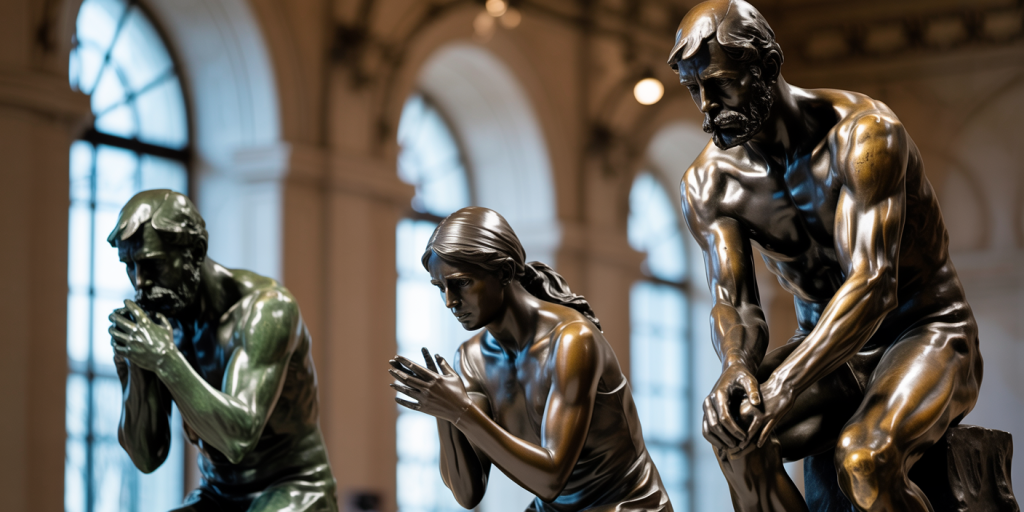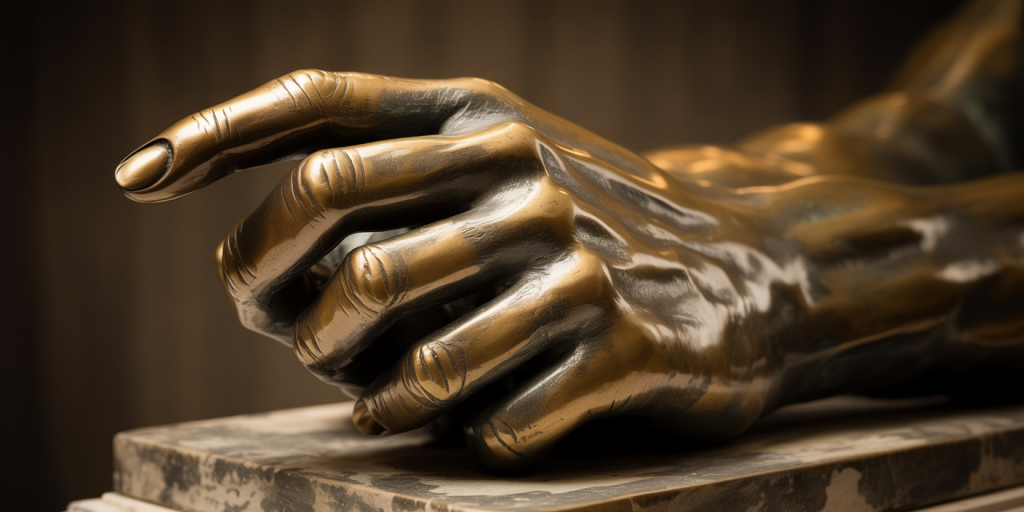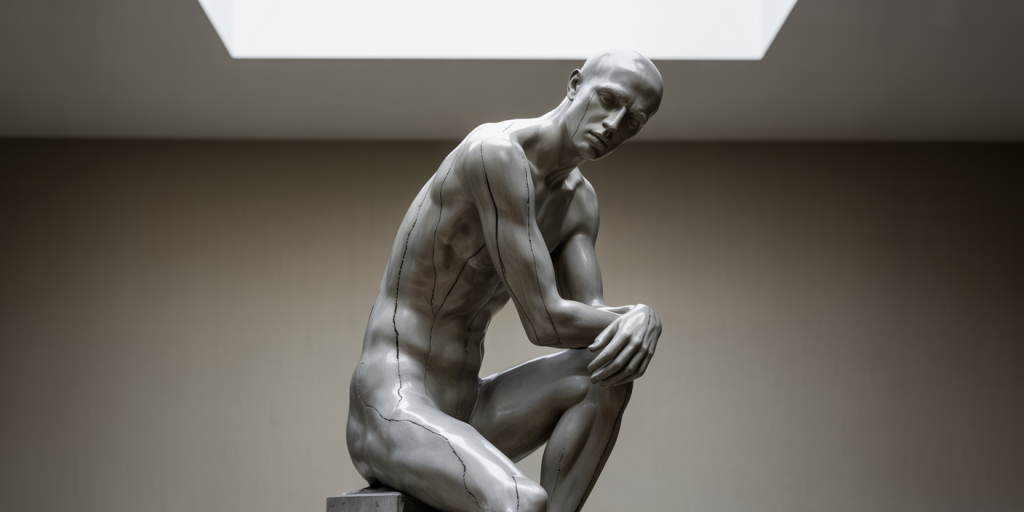The Weight of Silence: Rodin and the Thinking Matter
In the hush of stone, something stirs. A body leans, bends, emerges—half-buried in its own materiality. From the mute weight of bronze or marble rises a voice not spoken, but sculpted: a voice that trembles with doubt, passion, solitude. Rodin did not merely chisel figures—he liberated interior worlds, breathing consciousness into mass, thought into flesh, time into stillness.
Beneath his hands, form becomes introspection. Muscles ache with memory. Backs hunch under the gravity of feeling. In every creased brow and splayed toe, silence becomes a sonorous thing. To stand before a Rodin sculpture is to feel watched by something that contemplates you back—an architecture of emotion, a pulse beneath the patina.
Summary
- The Skin Beneath the Bronze
- Between Gesture and Eternity
- The Voice Trapped in Stone
- Hands That Grasp the Void
- Chiseled Shadows and Whispering Light
- The Anatomy of Solitude
- Echoes of Classical Memory
- Faces That Forget to Smile
- Of Torso and Truth
- When the Body Becomes a Question
- Cavities That Breathe
- Drapery Like Thought Made Fabric
- The Agony of Still Movement
- A Sculptor Who Listens to Silence
- The Passion of Imperfection
- Emotional Texture in Rough Surface
- Feet Rooted in the Invisible
- The Gaze That Weighs
- Matter as Emotion’s Mirror
The Skin Beneath the Bronze
Rodin’s figures rarely idealize. Their skin is coarse, interrupted, alive. This is not marble as mask but as membrane—pulsing with warmth, curling in places like bark or scar. His use of surface rejects the sleekness of Neoclassical beauty; instead, it embraces the tactile, the flawed, the felt.
Run your gaze along the jagged lines of The Thinker and you feel more than thought—you feel labor. Not mental abstraction, but physical exertion. The bronze is not polished but raw, as if the figure were still becoming, still thinking its own form into being.
Between Gesture and Eternity
Rodin captured the in-between moments—the half-turn, the almost-lift, the gesture suspended before completion. His sculptures inhabit liminal time: not frozen, but poised. As though at any second, they might exhale.
This temporal ambiguity breathes life into his compositions. It’s the difference between a statue and a presence. The Burghers of Calais, stooped in despair and resolve, embody this duality. Their bodies are heavy, but their gestures float in eternal suspension.

The Voice Trapped in Stone
In Rodin’s world, stone is not mute—it murmurs, pleads, protests. His Monument to Balzac doesn’t resemble the man, but the weight of his mind. Draped in thick folds of thought, the statue exudes internal pressure. It is Balzac not as image, but as psyche rendered in mineral.
Rodin turned sculpture into language. Not through replication, but suggestion. The folds speak. The hands ache. The eyes do not see; they remember.
Hands That Grasp the Void
Rodin’s hands are symphonies. They tremble, clench, yearn. In The Cathedral, two right hands nearly touch—cupped in an invisible vault. They create negative space that feels sacred, like breath held between lovers or prayer.
Hands in his work are not appendages; they are protagonists. They embody longing and reverence, grief and grace. In them, the entire body speaks.
Chiseled Shadows and Whispering Light
Rodin sculpted with chiaroscuro. His forms demand light not as illumination but as collaborator. The depth of his surfaces creates drama—shadows pool in folds, around eyes, between fingers. His sculpture absorbs and reflects light like a mood.
The effect is cinematic. Turn around The Kiss and light recasts the figures’ story. What was sensual becomes tender, then desperate. It is the interplay of photons and form that completes the sculpture’s voice.
The Anatomy of Solitude
Rodin’s figures often appear alone—even when paired. Their solitude is not absence, but presence intensified. In The Thinker, in Eve, in The Fallen Caryatid, the self folds inward. Muscles curl around emotion. These are not actors; they are introspective beings.
The solitude is structural. Bodies are bent, arms clasp torsos, heads bow. The posture becomes psychological. The body holds itself—not in vanity, but in self-reckoning.
Echoes of Classical Memory
Rodin worshipped Michelangelo but rewrote him. Where the Renaissance exalted balance and perfection, Rodin introduced fracture, incompleteness, the unresolved.
Many of his pieces are partial—torsos without heads, limbs without context. Yet they vibrate with life. These fragments are not ruins; they are essentials. As if Rodin, like a modern archaeologist of emotion, unearthed only what mattered.
Faces That Forget to Smile
Rodin’s faces rarely smile. They frown, pout, suffer, yearn. Even in pleasure, as with The Kiss, the expressions are grave. For Rodin, beauty was serious. Desire was solemn.
His expressions reach inward. Brows furrow not in rage but reflection. Cheeks sink under the weight of memory. The face becomes terrain—mapped by sorrow and sensuality alike.
Of Torso and Truth
The human torso in Rodin’s work is never simply anatomical. It becomes the seat of intuition. Arched backs, twisted spines, exposed rib cages—these are not just bodies; they are confessions in flesh.
In The Walking Man, the absence of head and arms only intensifies the drama of the torso. It strides forward not as body, but as force, as will embodied.
When the Body Becomes a Question
Rodin’s sculptures rarely answer. They ask. What is strength? What is shame? What does it mean to wait, to remember, to desire? The body is posed as a question mark—a symbol of human contradiction.
In The Age of Bronze, the ambiguity of gesture—arms lifted, unsure whether in defense or yearning—invites the viewer to project, to complete the thought. Rodin invites interpretation, not dictation.

Cavities That Breathe
Rodin carved emptiness with as much intention as mass. Between legs, in cupped hands, around open mouths—voids become voices. These negative spaces don’t silence the form; they amplify it.
In The Gates of Hell, darkness yawns between the figures, making them scream more loudly. Absence becomes presence. What is not sculpted weighs as heavily as what is.
Drapery Like Thought Made Fabric
Rodin’s drapery clings, folds, veils—and sometimes, it thinks. In The Martyr, fabric cascades over the female form like grief sliding down a body. The folds are not decorative—they’re emotional.
Drapery allows contrast. Against muscular thigh, it softens. Around a shoulder, it conceals. Rodin sculpts cloth like a poet sculpts metaphor: to reveal by veiling.
The Agony of Still Movement
Rodin perfected stillness in motion. His sculptures feel caught mid-sentence—gesture interrupted, turn frozen. This motionlessness isn’t death—it’s dramatic pause.
In The Prodigal Son, the figure kneels and stretches at once. It’s a paradox of direction—pulling forward, collapsing backward. The tension of movement suspended is where the emotion ignites.
A Sculptor Who Listens to Silence
Rodin listened. He listened to mass, to gesture, to the unspeakable. His silence is not mute—it is resonant. In every unfinished fragment, he grants space for the unsaid.
This is why his figures haunt. They feel like pauses in a symphony, breaths between verses. He carved absence into presence. Silence becomes sculpture.
The Passion of Imperfection
Rodin’s passion lay not in perfection but in process. He left thumbprints visible, let wax bubble, bronze blister. For him, the material’s truth was its imperfection.
In this roughness lies vulnerability. The surface becomes skin—wrinkled, bruised, real. It invites touch. It testifies to making, to becoming.

Emotional Texture in Rough Surface
Rodin’s emotional palette was built on texture. Smooth and raw cohabitate. In The Lovers, one back is polished as a mirror, the other unfinished. This contrast is a language.
The roughness isn’t lack—it’s deliberate. It evokes the emotional terrain of vulnerability. Love, doubt, sorrow—they all live in uneven surfaces.
Feet Rooted in the Invisible
Feet in Rodin’s work rarely rest. They push downward, sink, struggle. They often seem half-swallowed by their bases—as though reality tries to reclaim them.
These are not heroic pedestals. They are thresholds. His figures are suspended between the earthly and the ephemeral. The feet remind us: even in transcendence, gravity persists.
The Gaze That Weighs
Though many Rodin figures lack eyes—or have hollowed sockets—their gaze is undeniable. It’s felt more than seen. It arrives through posture, tilt, implication.
His gaze does not demand. It absorbs. The viewer becomes complicit. In Rodin’s world, to look is to carry a portion of the sculpture’s silence.
Matter as Emotion’s Mirror
Ultimately, Rodin made matter mirror emotion. Not illustrate it. Not decorate it. But embody it. His sculptures are not representations; they are presences.
And like presences, they change. With each viewing. With each angle. With each beam of light. They are not fixed. They are alive.
FAQ
Who was Auguste Rodin?
Rodin (1840–1917) was a French sculptor widely considered the progenitor of modern sculpture. His works include The Thinker, The Kiss, and The Gates of Hell.
What made Rodin’s style revolutionary?
He rejected academic idealization, embracing raw emotion, rough textures, and unfinished surfaces that emphasized process and psychological depth.
Why do many Rodin sculptures appear incomplete?
Rodin valued suggestion over completion. He believed fragments could express as much—if not more—than wholes, allowing the viewer’s imagination to engage.
What materials did Rodin use?
Primarily bronze and marble, but he also worked in clay and plaster. He often collaborated with assistants for casting and enlargement.
What is the significance of The Thinker?
Originally part of The Gates of Hell, it has come to symbolize introspection, creativity, and the physical embodiment of thought.
The Weight of What Is Not Said
Rodin’s work does not shout. It leans close, whispers, waits. Its weight is not only material, but emotional. He did not seek to decorate space—but to awaken silence.
In every fold of flesh, every twist of torso, every grasping hand, Rodin gave form to the intangible. Thought. Grief. Desire. Solitude.
And so, his sculptures remain—half-human, half-idea. Still. Heavy. Alive.
